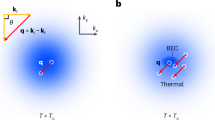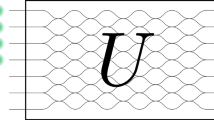Abstract
Fifty years ago, Hanbury Brown and Twiss (HBT) discovered photon bunching in light emitted by a chaotic source1, highlighting the importance of two-photon correlations2 and stimulating the development of modern quantum optics3. The quantum interpretation of bunching relies on the constructive interference between amplitudes involving two indistinguishable photons, and its additive character is intimately linked to the Bose nature of photons. Advances in atom cooling and detection have led to the observation and full characterization of the atomic analogue of the HBT effect with bosonic atoms4,5,6. By contrast, fermions should reveal an antibunching effect (a tendency to avoid each other). Antibunching of fermions is associated with destructive two-particle interference, and is related to the Pauli principle forbidding more than one identical fermion to occupy the same quantum state. Here we report an experimental comparison of the fermionic and bosonic HBT effects in the same apparatus, using two different isotopes of helium: 3He (a fermion) and 4He (a boson). Ordinary attractive or repulsive interactions between atoms are negligible; therefore, the contrasting bunching and antibunching behaviour that we observe can be fully attributed to the different quantum statistics of each atomic species. Our results show how atom–atom correlation measurements can be used to reveal details in the spatial density7,8 or momentum correlations9 in an atomic ensemble. They also enable the direct observation of phase effects linked to the quantum statistics of a many-body system, which may facilitate the study of more exotic situations10.
This is a preview of subscription content, access via your institution
Access options
Subscribe to this journal
Receive 51 print issues and online access
$199.00 per year
only $3.90 per issue
Buy this article
- Purchase on Springer Link
- Instant access to full article PDF
Prices may be subject to local taxes which are calculated during checkout



Similar content being viewed by others
References
Hanbury Brown, R. & Twiss, R. Q. Correlation between photons in two coherent beams of light. Nature 177, 27–29 (1956)
Scully, M. O. & Zubairy, M. S. Quantum Optics (Cambridge Univ. Press, Cambridge, UK, 1997)
Glauber, R. J. in Quantum Optics and Electronics (eds DeWitt, C., Blandin, A. & Cohen-Tannoudji, C.) 63–185 (Gordon and Breach, New York, 1965)
Yasuda, M. & Shimizu, F. Observation of two-atom correlation of an ultracold neon atomic beam. Phys. Rev. Lett. 77, 3090–3093 (1996)
Schellekens, M. et al. Hanbury Brown Twiss effect for ultracold quantum gases. Science 310, 648–651 (2005); published online 15 September 2005 (doi:10.1126/science.1118024).
Öttl, A., Ritter, S., Köhl, M. & Esslinger, T. Correlations and counting statistics on an atom laser. Phys. Rev. Lett. 95, 090404 (2005)
Fölling, S. et al. Spatial quantum noise interferometry in expanding condensates. Nature 434, 481–484 (2005)
Spielman, I. B., Phillips, W. D. & Porto, J. V. The Mott insulator transition in two dimensions. Preprint at 〈http://arxiv.org/cond-mat/0606216〉 (2006)
Greiner, M., Regal, C. A., Stewart, J. T. & Jin, D. S. Probing pair-correlated fermionic atoms through correlations in atom shot noise. Phys. Rev. Lett. 94, 110401 (2005)
Altman, E., Demler, E. & Lukin, M. D. Probing many-body states of ultracold atoms via noise correlations. Phys. Rev. A 70, 013603 (2004)
Grondalski, J., Alsing, P. M. & Deutsch, I. H. Spatial correlation diagnostics for atoms in optical lattices. Opt. Express 5, 249–261 (1999)
Hellweg, D. et al. Measurement of the spatial correlation function of phase fluctuating Bose-Einstein condensates. Phys. Rev. Lett. 91, 010406 (2003)
Estève, J. et al. Observations of density fluctuations in an elongated Bose gas: ideal gas and quasicondensate regimes. Phys. Rev. Lett. 96, 130403 (2006)
Loudon, R. The Quantum Theory of Light 3rd edn (Oxford Univ. Press, Oxford, 2000)
Fano, U. Quantum theory of interference effects in the mixing of light from phase independent sources. Am. J. Phys. 29, 539–545 (1961)
Hanbury Brown, R. & Twiss, R. Q. A test of a new stellar interferometer on Sirius. Nature 178, 1046–1048 (1956)
Baym, G. The physics of Hanbury Brown-Twiss intensity interferometry: From stars to nuclear collisions. Acta Phys. Pol. B 29, 1839–1884 (1998)
Boal, D. H., Gelbke, C.-K. & Jennings, B. K. Intensity interferometry in subatomic physics. Rev. Mod. Phys. 62, 553–602 (1990)
Viana Gomes, J. et al. Theory for a Hanbury Brown Twiss experiment with a ballistically expanding cloud of cold atoms. Phys. Rev. A 74, 053607 (2006)
Kimble, H. J., Dagenais, M. & Mandel, L. Photon antibunching in resonance fluorescence. Phys. Rev. Lett. 39, 691–695 (1978)
Henny, M. et al. The fermionic Hanbury Brown and Twiss experiment. Science 284, 296–298 (1999)
Oliver, W. D., Kim, J., Liu, R. C. & Yamamoto, Y. Hanbury Brown and Twiss-type experiment with electrons. Science 284, 299–301 (1999)
Kiesel, H., Renz, A. & Hasselbach, F. Observation of Hanbury Brown-Twiss anticorrelations for free electrons. Nature 418, 392–394 (2002)
Iannuzzi, M., Orecchini, A., Sacchetti, F., Facchi, P. & Pascazio, S. Direct experimental evidence of free-fermion antibunching. Phys. Rev. Lett. 96, 080402 (2006)
Rom, T. et al. Free fermion antibunching in a degenerate atomic Fermi gas released from an optical lattice. Nature 444, 733–736 (2006)
Jagutzki, O. et al. A broad-application microchannel-plate detector system for advanced particle or photon detection tasks: Large area imaging, precise multi-hit timing information and high detection rate. Nucl. Instrum. Methods Phys. Res. A 477, 244–249 (2002)
McNamara, J. M., Jeltes, T., Tychkov, A. S., Hogervorst, W. & Vassen, W. Degenerate Bose-Fermi mixture of metastable atoms. Phys. Rev. Lett. 97, 080404 (2006)
Girardeau, M. Relationship between systems of impenetrable bosons and fermions in one dimension. J. Math. Phys. (NY) 1, 516–523 (1960)
Olshanii, M. Atomic scattering in the presence of an external confinement and a gas of impenetrable bosons. Phys. Rev. Lett. 81, 938–941 (1998)
Tychkov, A. S. et al. Metastable helium Bose-Einstein condensate with a large number of atoms. Phys. Rev. A 73, 031603(R) (2006)
Acknowledgements
This work was supported by the access programme of Laserlab Europe. The LCVU group in Amsterdam is supported by the ‘Cold Atoms’ programme of the Dutch Foundation for Fundamental Research on Matter (FOM) and by the Space Research Organization Netherlands (SRON). The Atom Optics group of LCFIO is a member of the IFRAF institute and of the Fédération LUMAT of the CNRS, and is supported by the French ANR and by the SCALA programme of the European Union.
Author information
Authors and Affiliations
Corresponding authors
Ethics declarations
Competing interests
Reprints and permissions information is available at www.nature.com/reprints. The authors declare no competing financial interests.
Supplementary information
Supplementary Information
This file contains Supplementary Figures 1-2 with legends and Supplementary Table 1 with Supplementary Data and commentary concerning the correlation length measurements. The Supplementary Figure 1 shows two examples of unnormalized histograms. The Supplementary Figure 2 and the Supplementary Table 1 show the detailed results our fits to a theoretical model. (PDF 530 kb)
Rights and permissions
About this article
Cite this article
Jeltes, T., McNamara, J., Hogervorst, W. et al. Comparison of the Hanbury Brown–Twiss effect for bosons and fermions. Nature 445, 402–405 (2007). https://doi.org/10.1038/nature05513
Received:
Accepted:
Issue Date:
DOI: https://doi.org/10.1038/nature05513
This article is cited by
-
Microscopes go molecular
Nature Physics (2022)
-
Observation of Cooper pairs in a mesoscopic two-dimensional Fermi gas
Nature (2022)
-
On the survival of the quantum depletion of a condensate after release from a magnetic trap
Scientific Reports (2022)
-
Observation of the Hanbury Brown–Twiss effect with ultracold molecules
Nature Physics (2022)
-
Cold atoms stay cool
Nature Physics (2021)
Comments
By submitting a comment you agree to abide by our Terms and Community Guidelines. If you find something abusive or that does not comply with our terms or guidelines please flag it as inappropriate.



